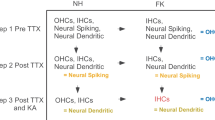Summary
Scala tympani (ST) in guinea pig was perfused with modified Ringer's solutions containing 5–50 mM potassium; tone-induced cochlear responses from the basal turn of ST were compared before, during and after perfusions.
The compound nerve action potential (N1) and afterpotential (a/p) amplitudes were reduced, especially above 20 mM; the summating potential (SP) was variable, but its onset shape changed consistently with 13–20 mM levels. However, the cochlear microphonic amplitude (CM) remained substantially unchanged even at the 35 mM level. K+ concentration was monitored in ST with ion-sensitive pipettes. Stable levels were reached within 2 min, but N1 responses continued to fall beyond this time. Recovery to normal K+ levels took place spontaneously and the concentration curve which resulted showed a 2-slope characteristic.
These experiments question whether elevated potassium concentration in scala tympani depolarizes the hair cells, and if it does, whether the hair cell resting potential is involved in the generation of the CM.
Similar content being viewed by others
References
Angelborg, C., Engström, B.: Inner Ear Studies II. 3. The tympanic covering layer. An electron microscope study in guinea pig. Acta Otolaryngol. [Suppl.] (Stockh.) 319, 43–56 (1974)
Butler, R.A.: Some experimental observations on the d.c. resting potentials in the guinea pig cochlea. J. Acoust. Soc. Am. 37, 429–433 (1965)
Dallos, P.: On the negative potential within the organ of Corti. J. Acoust. Soc. Am. 44, 818–819 (1968)
Dallos, P.: The Auditory Periphery — Biophysics and Physiology, pp. 386–388. London: Academic Press 1973
Davis, H.: Some principles of sensory receptor action. Physiol. Rev. 41, 391–416 (1961)
Dohlman, G.F.: Histochemical studies of vestibular mechanisms. In: Neural Mechanisms of the Auditory and Vestibular Systems (eds. G.L. Rasmussen and W.F. Windle), Chapter 19, pp. 258–275. Springfield: Thomas 1960
Flock, A.: Electron probe determination of relative ion distribution in the inner ear. Acta Otolaryngol. (Stockh.) 83, 239–244 (1977)
Galley, N., Klinke, R., Oertel, W., Pause, M., Storch, W.H.: The effect of intracochlearly administered acetylcholine — blocking agents on the efferent synapses of the cochlea. Brain Res. 64, 55–63 (1973)
Hawkins, J.E., Jr.: Vascular patterns of the membranous labyrinth. In: Third Symposium on the Role of the Vestibular Organs in Space Exploration (ed. A. Graybiel) pp. 241–257. NASA SP-152 (1967)
Hodgkin, A.L., Horowicz, P.: The influence of potassium and chloride ions on the membrane potential of single muscle fibres. J. Physiol. (Lond.) 148, 127–160 (1959)
Honrubia, V., Ward, P.H.: Dependence of the cochlear microphonics and the summating potential on the endocochlear potential. J. Acoust. Soc. Am. 46, 388–392 (1969)
Ilberg, C.V., Vosteen, K.H.: Permeability of the inner ear membranes. Acta Otolaryngol. (Stockh.) 67, 165–170 (1969)
Kohllöffel, L.U.E.: Studies of the distribution of cochlear potentials along the basilar membrane. Acta Otolaryngol. [Suppl.] (Stockh.) 288, 1–66 (1971)
Konishi, T., Kelsey, E.: Effect of sodium deficiency on cochlear potentials. J. Acoust. Soc. Am. 43, 462–470 (1968)
Konishi, T., Kelsey, E.: Effect of potassium deficiency on the cochlear potentials and cation contents of the endolymph. Acta Otolaryngol. (Stockh.) 76, 410–418 (1973)
Kuffler, S.W.: Neuroglial cells: physiological properties and a potassium mediated effect of neuronal activity on the glial membrane potential. Proc. R. Soc. Lond. [B.] 168, 1–21 (1967)
Lawrence, M.: Dynamic range of the cochlear transducer. Cold Spring Harbor Symp. Quant. Biol. 30, 159–167 (1965)
Lawrence, M.: Resting potentials in the inner sulcus and tunnel of Corti. Acta Otolaryngol. (Stockh.) 79, 304–309 (1975)
Lim, D.J.: Surface ultrastructure of the cochlear perilymphatic space. J. Laryngol. Otol. 84, 413–428 (1970)
Lowenstein, O.E.: Comparative Morphology and Physiology. In: Handbook of Sensory Physiology VI/I (ed. H.H. Kornhuber), Chapter 2, pp. 75–120 New York: Springer 1974
Naftalin, L.: Some new proposals regarding acoustic transmission and transduction. Cold Spring Harbor Symp. Quant. Biol. 30, 169–180 (1965)
Naftalin, L.: The peripheral hearing mechanism: a biochemical and biological approach. Ann. Otol. Rhinol. Laryngol. 85, 38–42 (1976)
Panayiotopoulos, C.P., Stopp, P.E.: The characteristics of the cochlear after-potential studied in the guinea-pig by perfusion and stimulation. J. Physiol. (Lond.) 210, 495–505 (1970)
Salt, A. N.: A study into the effect of elevated potassium concentration on cochlear potentials. M. Sc. report. University of Birmingham 1974
Salt, A.N.: The effect of increased perilymph potassium concentration on the responses of the guinea pig cochlea and factors involved in the time course of recovery. Ph.D. thesis. University of Birmingham 1977
Sellick, P.M., Bock, G.R.: Evidence for the electrogenic potassium pump as the origin of the positive component of the endocochlear potential. Pflügers Arch. 352, 351–362 (1974)
Sellick, P.M., Johnstone, B.M.: Production and role of inner ear fluid. Prog. Neurobiol. 5, 337–362 (1975)
Spoendlin, H.: The Organization of the Cochlear Receptor. Advances in Oto-Rhino-Laryngology. Vol. 13. Basel: Karger 1966
Stopp, P.E.: The transient electric responses of the cochlea. J. Physiol. (Lond.) 205, 353–365 (1969)
Tanaka, Y., Asanuma, A., Yanagisawa, K., Katsuki, Y.: Electrical potentials of the subtectorial space in the guinea pig cochlea. Jpn. J. Physiol. 27, 539–549 (1977)
Tasaki, I., Fernández, C.: Modification of cochlear microphonics and action potentials by KCl solution and by direct currents. J. Neurophysiol. 15, 497–512 (1952)
Tasaki, I., Davis, H., Eldredge, D.H.: Exploration of cochlear potentials in guinea pig with a microelectrode. J. Acoust. Soc. Am. 26, 765–773 (1954)
Walker, J.L., Jr.: Ion specific liquid ion exchanger microelectrodes. Anal. Chem. 43, 89A-93A (1971)
Author information
Authors and Affiliations
Rights and permissions
About this article
Cite this article
Salt, A.N., Stopp, P.E. The effect of raising the scala tympani potassium concentration on the tone-induced cochlear responses of the guinea pig. Exp Brain Res 36, 87–98 (1979). https://doi.org/10.1007/BF00238469
Received:
Issue Date:
DOI: https://doi.org/10.1007/BF00238469




